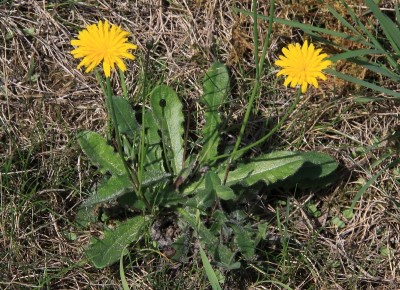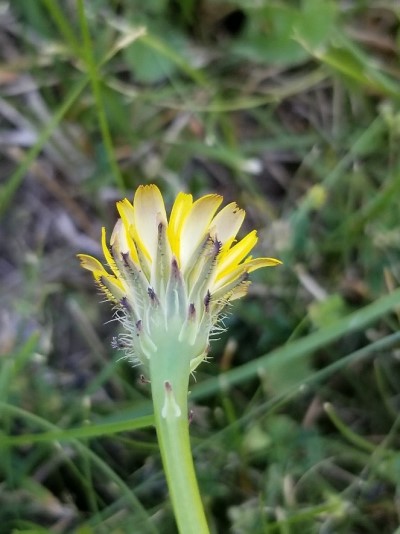Hairy Cat's Ear (Hypochaeris radicata)
Introduction
We have recently received several questions about hairy cat’s ear (Hypochaeris radicata). This species is in the Asteraceace family and was introduced to North America from Europe. It superficially resembles dandelion (Taraxacum officinale). Other common names include flatweed and false dandelion.
Identification and biology

Flowering Hairy cat's ear. Photo by Peter Meininger, Saxifraga Foundation.

Hairy cat's ear flower underside. Photo by Dave Brink, MSU Extension.
Hairy cat’s ear is a perennial species. It has many features that resemble dandelion including milky sap, leaves arranged in a rosette at the base of the plant, yellow flower heads that have ray flowers only, single flowers at the end of stems, and plumed seeds that are dispersed by the wind. One important and easy- to-recognize feature that distinguishes it from dandelion is the presence of branched stems. Hairy cat’s ear also has hairy leaves and lower stems while dandelion does not. This species may have a taproot and/or fibrous roots.
Habitat and spread
Hairy cat’s ear grows in disturbed areas like roadsides, lawns, and pastures. Seeds are spread by wind. To our knowledge it’s present distribution in Montana is limited to western counties (Flathead, Lake, Lincoln, Mineral, Missoula, Ravalli, and Sanders counties).
Impacts
Hairy cat’s ear has toxic properties that impact horses. Horses grazing on this plant can develop symptoms of stringhalt, a specific type of hind leg lameness. Over time the leg muscles can atrophy in chronic cases. Other impacts observed by land managers include encroachment into disturbed areas in lawn, roadside and pasture habitats. This species in on the noxious weed list in Washington.
Management options
As with many weeds that occur in disturbed areas, limiting bare ground and encouraging competitive, perennial plants will help prevent establishment of hairy cat’s ear and slow spread of existing populations. Mechanical control options include handpulling or digging. It is important to sever the taproot several inches below the root crown because this species is capable of resprouting from the taproot. Mowing is not effective because the leaves grow below the height of mower blades and plants can readily flower after mowing. There are several selective herbicides that are reported to provide control of hairy cat’s ear. See the link below for details.
More information about biology and management (346KB PDF)
More information about toxicity
Further Information
For more information on this month's Weed Post, contact Extension Invasive Plants specialist Jane Mangold. Past posts are available in the Monthly Weed Post directory.
The Printable PDF (580KB) version of this post includes a crossword puzzle.

